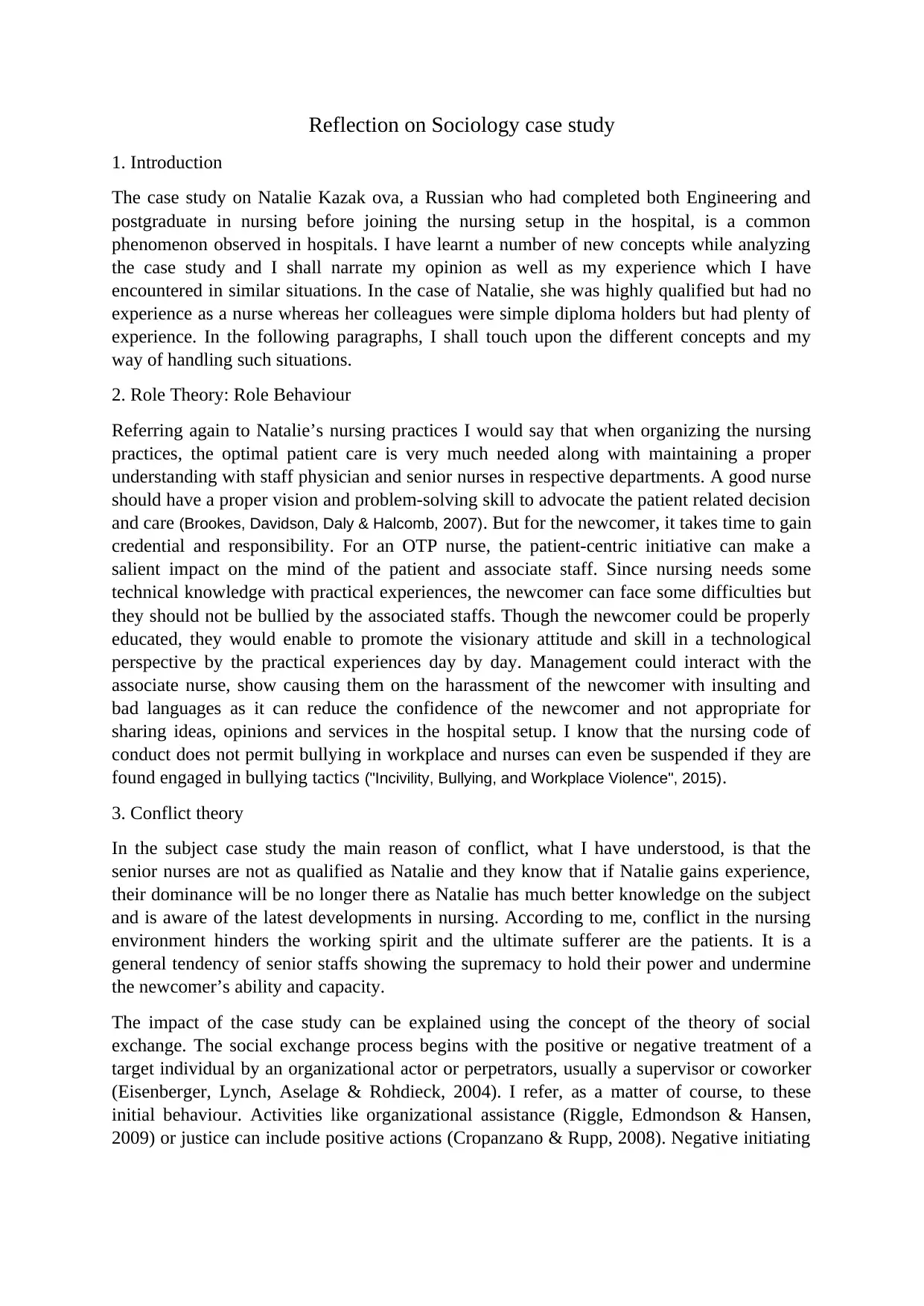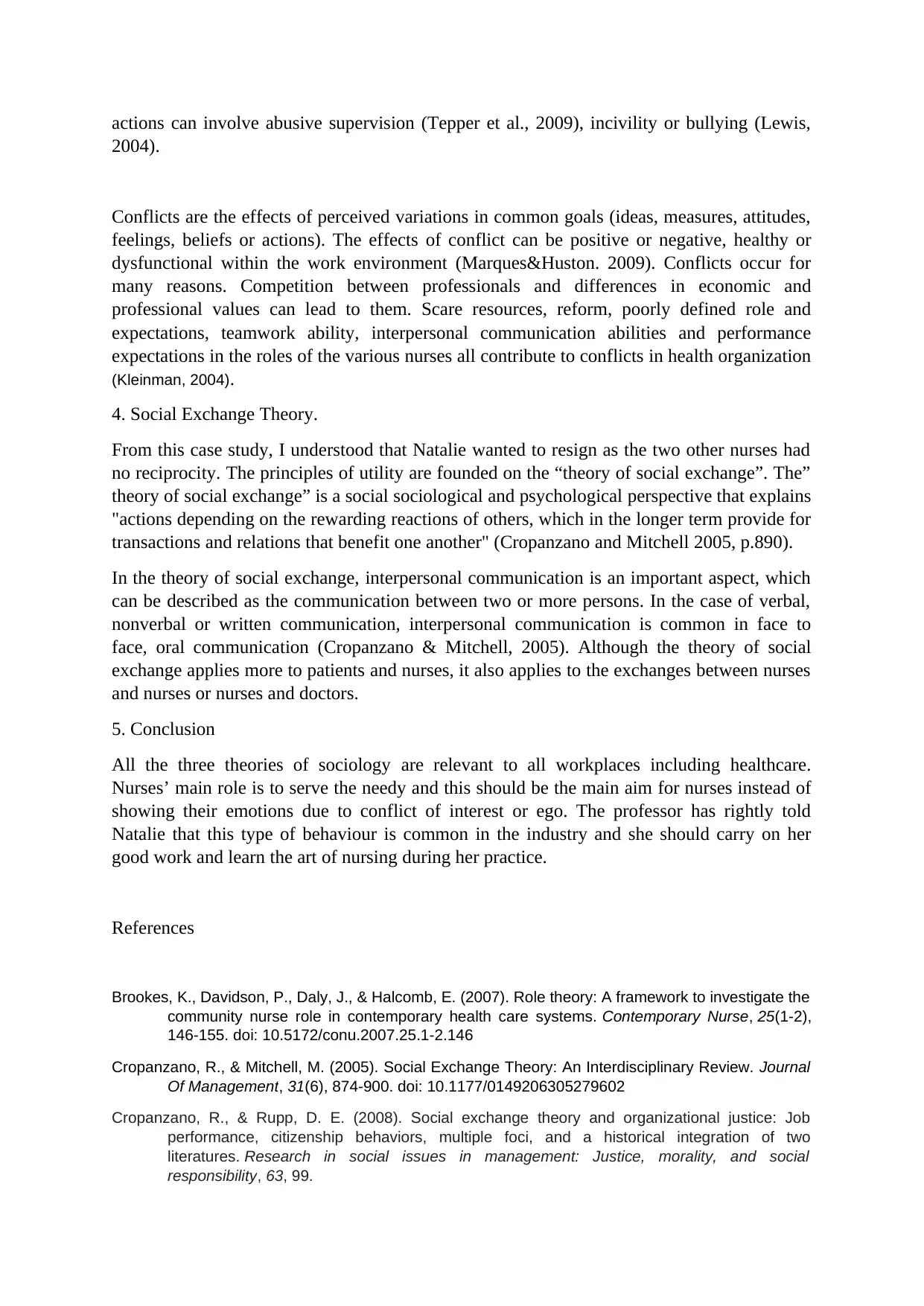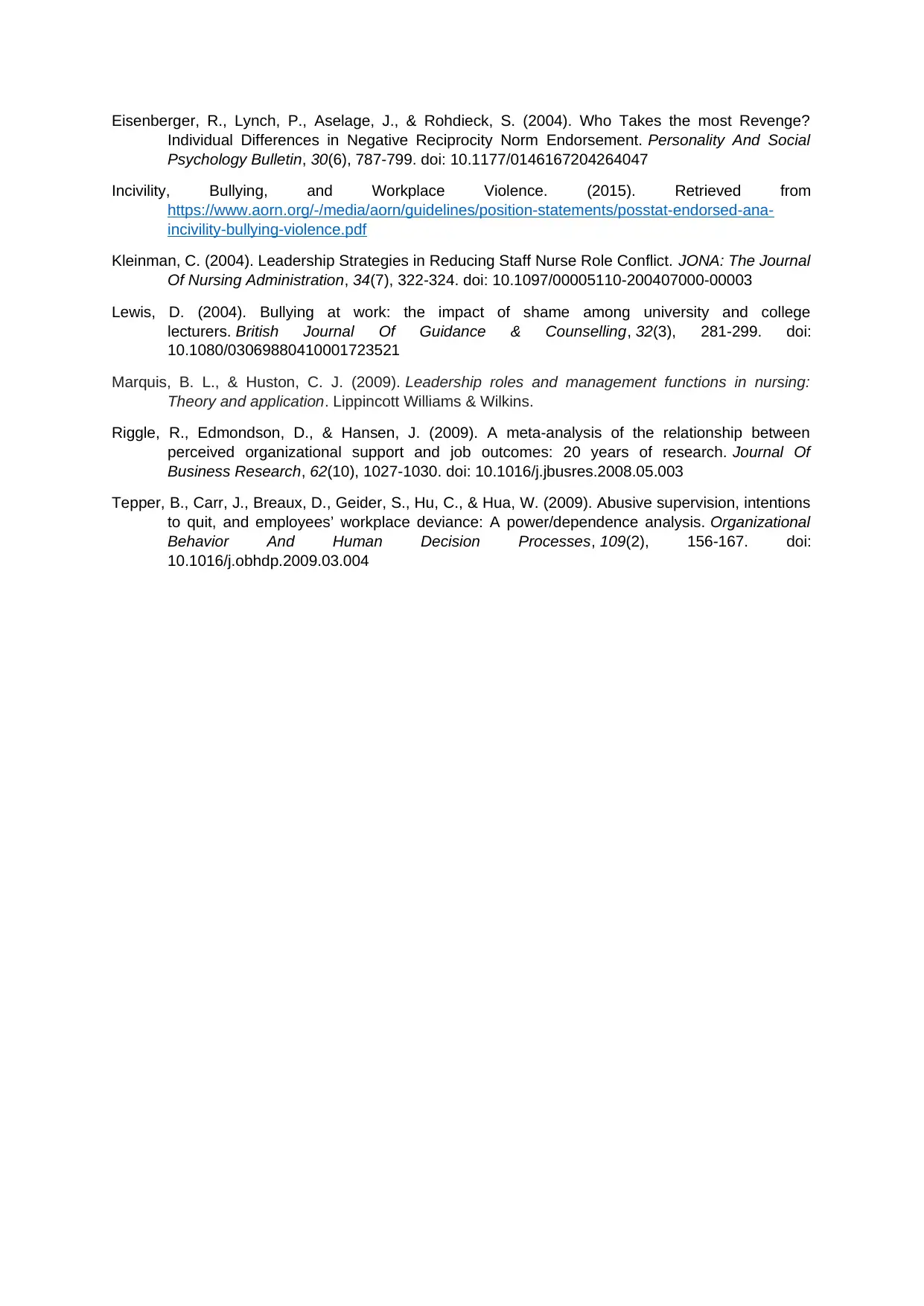Reflective Journal: Sociology Case Study on Nursing Workplace Issues
VerifiedAdded on 2023/03/29
|3
|1124
|249
Journal and Reflective Writing
AI Summary
This assignment is a reflective journal entry analyzing a sociology case study centered around Natalie Kazakova, a Russian immigrant with degrees in engineering and nursing working in a hospital ICU. The reflection explores the challenges Natalie faces due to her lack of experience and conflicts with senior nurses. It applies three sociological theories—Role Theory, Conflict Theory, and Social Exchange Theory—to understand the dynamics at play. Role Theory explains Natalie's struggle to negotiate her role as a new nurse, while Conflict Theory highlights the power struggles and dominance issues with experienced but less qualified nurses. Social Exchange Theory examines the lack of reciprocity and its impact on Natalie's decision to resign. The reflection concludes that while such behaviors are common in healthcare, nurses should prioritize patient care and learn to navigate workplace conflicts effectively, emphasizing the importance of interpersonal communication and understanding in maintaining a positive work environment.

Reflection on Sociology case study
1. Introduction
The case study on Natalie Kazak ova, a Russian who had completed both Engineering and
postgraduate in nursing before joining the nursing setup in the hospital, is a common
phenomenon observed in hospitals. I have learnt a number of new concepts while analyzing
the case study and I shall narrate my opinion as well as my experience which I have
encountered in similar situations. In the case of Natalie, she was highly qualified but had no
experience as a nurse whereas her colleagues were simple diploma holders but had plenty of
experience. In the following paragraphs, I shall touch upon the different concepts and my
way of handling such situations.
2. Role Theory: Role Behaviour
Referring again to Natalie’s nursing practices I would say that when organizing the nursing
practices, the optimal patient care is very much needed along with maintaining a proper
understanding with staff physician and senior nurses in respective departments. A good nurse
should have a proper vision and problem-solving skill to advocate the patient related decision
and care (Brookes, Davidson, Daly & Halcomb, 2007). But for the newcomer, it takes time to gain
credential and responsibility. For an OTP nurse, the patient-centric initiative can make a
salient impact on the mind of the patient and associate staff. Since nursing needs some
technical knowledge with practical experiences, the newcomer can face some difficulties but
they should not be bullied by the associated staffs. Though the newcomer could be properly
educated, they would enable to promote the visionary attitude and skill in a technological
perspective by the practical experiences day by day. Management could interact with the
associate nurse, show causing them on the harassment of the newcomer with insulting and
bad languages as it can reduce the confidence of the newcomer and not appropriate for
sharing ideas, opinions and services in the hospital setup. I know that the nursing code of
conduct does not permit bullying in workplace and nurses can even be suspended if they are
found engaged in bullying tactics ("Incivility, Bullying, and Workplace Violence", 2015).
3. Conflict theory
In the subject case study the main reason of conflict, what I have understood, is that the
senior nurses are not as qualified as Natalie and they know that if Natalie gains experience,
their dominance will be no longer there as Natalie has much better knowledge on the subject
and is aware of the latest developments in nursing. According to me, conflict in the nursing
environment hinders the working spirit and the ultimate sufferer are the patients. It is a
general tendency of senior staffs showing the supremacy to hold their power and undermine
the newcomer’s ability and capacity.
The impact of the case study can be explained using the concept of the theory of social
exchange. The social exchange process begins with the positive or negative treatment of a
target individual by an organizational actor or perpetrators, usually a supervisor or coworker
(Eisenberger, Lynch, Aselage & Rohdieck, 2004). I refer, as a matter of course, to these
initial behaviour. Activities like organizational assistance (Riggle, Edmondson & Hansen,
2009) or justice can include positive actions (Cropanzano & Rupp, 2008). Negative initiating
1. Introduction
The case study on Natalie Kazak ova, a Russian who had completed both Engineering and
postgraduate in nursing before joining the nursing setup in the hospital, is a common
phenomenon observed in hospitals. I have learnt a number of new concepts while analyzing
the case study and I shall narrate my opinion as well as my experience which I have
encountered in similar situations. In the case of Natalie, she was highly qualified but had no
experience as a nurse whereas her colleagues were simple diploma holders but had plenty of
experience. In the following paragraphs, I shall touch upon the different concepts and my
way of handling such situations.
2. Role Theory: Role Behaviour
Referring again to Natalie’s nursing practices I would say that when organizing the nursing
practices, the optimal patient care is very much needed along with maintaining a proper
understanding with staff physician and senior nurses in respective departments. A good nurse
should have a proper vision and problem-solving skill to advocate the patient related decision
and care (Brookes, Davidson, Daly & Halcomb, 2007). But for the newcomer, it takes time to gain
credential and responsibility. For an OTP nurse, the patient-centric initiative can make a
salient impact on the mind of the patient and associate staff. Since nursing needs some
technical knowledge with practical experiences, the newcomer can face some difficulties but
they should not be bullied by the associated staffs. Though the newcomer could be properly
educated, they would enable to promote the visionary attitude and skill in a technological
perspective by the practical experiences day by day. Management could interact with the
associate nurse, show causing them on the harassment of the newcomer with insulting and
bad languages as it can reduce the confidence of the newcomer and not appropriate for
sharing ideas, opinions and services in the hospital setup. I know that the nursing code of
conduct does not permit bullying in workplace and nurses can even be suspended if they are
found engaged in bullying tactics ("Incivility, Bullying, and Workplace Violence", 2015).
3. Conflict theory
In the subject case study the main reason of conflict, what I have understood, is that the
senior nurses are not as qualified as Natalie and they know that if Natalie gains experience,
their dominance will be no longer there as Natalie has much better knowledge on the subject
and is aware of the latest developments in nursing. According to me, conflict in the nursing
environment hinders the working spirit and the ultimate sufferer are the patients. It is a
general tendency of senior staffs showing the supremacy to hold their power and undermine
the newcomer’s ability and capacity.
The impact of the case study can be explained using the concept of the theory of social
exchange. The social exchange process begins with the positive or negative treatment of a
target individual by an organizational actor or perpetrators, usually a supervisor or coworker
(Eisenberger, Lynch, Aselage & Rohdieck, 2004). I refer, as a matter of course, to these
initial behaviour. Activities like organizational assistance (Riggle, Edmondson & Hansen,
2009) or justice can include positive actions (Cropanzano & Rupp, 2008). Negative initiating
Paraphrase This Document
Need a fresh take? Get an instant paraphrase of this document with our AI Paraphraser

actions can involve abusive supervision (Tepper et al., 2009), incivility or bullying (Lewis,
2004).
Conflicts are the effects of perceived variations in common goals (ideas, measures, attitudes,
feelings, beliefs or actions). The effects of conflict can be positive or negative, healthy or
dysfunctional within the work environment (Marques&Huston. 2009). Conflicts occur for
many reasons. Competition between professionals and differences in economic and
professional values can lead to them. Scare resources, reform, poorly defined role and
expectations, teamwork ability, interpersonal communication abilities and performance
expectations in the roles of the various nurses all contribute to conflicts in health organization
(Kleinman, 2004).
4. Social Exchange Theory.
From this case study, I understood that Natalie wanted to resign as the two other nurses had
no reciprocity. The principles of utility are founded on the “theory of social exchange”. The”
theory of social exchange” is a social sociological and psychological perspective that explains
"actions depending on the rewarding reactions of others, which in the longer term provide for
transactions and relations that benefit one another" (Cropanzano and Mitchell 2005, p.890).
In the theory of social exchange, interpersonal communication is an important aspect, which
can be described as the communication between two or more persons. In the case of verbal,
nonverbal or written communication, interpersonal communication is common in face to
face, oral communication (Cropanzano & Mitchell, 2005). Although the theory of social
exchange applies more to patients and nurses, it also applies to the exchanges between nurses
and nurses or nurses and doctors.
5. Conclusion
All the three theories of sociology are relevant to all workplaces including healthcare.
Nurses’ main role is to serve the needy and this should be the main aim for nurses instead of
showing their emotions due to conflict of interest or ego. The professor has rightly told
Natalie that this type of behaviour is common in the industry and she should carry on her
good work and learn the art of nursing during her practice.
References
Brookes, K., Davidson, P., Daly, J., & Halcomb, E. (2007). Role theory: A framework to investigate the
community nurse role in contemporary health care systems. Contemporary Nurse, 25(1-2),
146-155. doi: 10.5172/conu.2007.25.1-2.146
Cropanzano, R., & Mitchell, M. (2005). Social Exchange Theory: An Interdisciplinary Review. Journal
Of Management, 31(6), 874-900. doi: 10.1177/0149206305279602
Cropanzano, R., & Rupp, D. E. (2008). Social exchange theory and organizational justice: Job
performance, citizenship behaviors, multiple foci, and a historical integration of two
literatures. Research in social issues in management: Justice, morality, and social
responsibility, 63, 99.
2004).
Conflicts are the effects of perceived variations in common goals (ideas, measures, attitudes,
feelings, beliefs or actions). The effects of conflict can be positive or negative, healthy or
dysfunctional within the work environment (Marques&Huston. 2009). Conflicts occur for
many reasons. Competition between professionals and differences in economic and
professional values can lead to them. Scare resources, reform, poorly defined role and
expectations, teamwork ability, interpersonal communication abilities and performance
expectations in the roles of the various nurses all contribute to conflicts in health organization
(Kleinman, 2004).
4. Social Exchange Theory.
From this case study, I understood that Natalie wanted to resign as the two other nurses had
no reciprocity. The principles of utility are founded on the “theory of social exchange”. The”
theory of social exchange” is a social sociological and psychological perspective that explains
"actions depending on the rewarding reactions of others, which in the longer term provide for
transactions and relations that benefit one another" (Cropanzano and Mitchell 2005, p.890).
In the theory of social exchange, interpersonal communication is an important aspect, which
can be described as the communication between two or more persons. In the case of verbal,
nonverbal or written communication, interpersonal communication is common in face to
face, oral communication (Cropanzano & Mitchell, 2005). Although the theory of social
exchange applies more to patients and nurses, it also applies to the exchanges between nurses
and nurses or nurses and doctors.
5. Conclusion
All the three theories of sociology are relevant to all workplaces including healthcare.
Nurses’ main role is to serve the needy and this should be the main aim for nurses instead of
showing their emotions due to conflict of interest or ego. The professor has rightly told
Natalie that this type of behaviour is common in the industry and she should carry on her
good work and learn the art of nursing during her practice.
References
Brookes, K., Davidson, P., Daly, J., & Halcomb, E. (2007). Role theory: A framework to investigate the
community nurse role in contemporary health care systems. Contemporary Nurse, 25(1-2),
146-155. doi: 10.5172/conu.2007.25.1-2.146
Cropanzano, R., & Mitchell, M. (2005). Social Exchange Theory: An Interdisciplinary Review. Journal
Of Management, 31(6), 874-900. doi: 10.1177/0149206305279602
Cropanzano, R., & Rupp, D. E. (2008). Social exchange theory and organizational justice: Job
performance, citizenship behaviors, multiple foci, and a historical integration of two
literatures. Research in social issues in management: Justice, morality, and social
responsibility, 63, 99.

Eisenberger, R., Lynch, P., Aselage, J., & Rohdieck, S. (2004). Who Takes the most Revenge?
Individual Differences in Negative Reciprocity Norm Endorsement. Personality And Social
Psychology Bulletin, 30(6), 787-799. doi: 10.1177/0146167204264047
Incivility, Bullying, and Workplace Violence. (2015). Retrieved from
https://www.aorn.org/-/media/aorn/guidelines/position-statements/posstat-endorsed-ana-
incivility-bullying-violence.pdf
Kleinman, C. (2004). Leadership Strategies in Reducing Staff Nurse Role Conflict. JONA: The Journal
Of Nursing Administration, 34(7), 322-324. doi: 10.1097/00005110-200407000-00003
Lewis, D. (2004). Bullying at work: the impact of shame among university and college
lecturers. British Journal Of Guidance & Counselling, 32(3), 281-299. doi:
10.1080/03069880410001723521
Marquis, B. L., & Huston, C. J. (2009). Leadership roles and management functions in nursing:
Theory and application. Lippincott Williams & Wilkins.
Riggle, R., Edmondson, D., & Hansen, J. (2009). A meta-analysis of the relationship between
perceived organizational support and job outcomes: 20 years of research. Journal Of
Business Research, 62(10), 1027-1030. doi: 10.1016/j.jbusres.2008.05.003
Tepper, B., Carr, J., Breaux, D., Geider, S., Hu, C., & Hua, W. (2009). Abusive supervision, intentions
to quit, and employees’ workplace deviance: A power/dependence analysis. Organizational
Behavior And Human Decision Processes, 109(2), 156-167. doi:
10.1016/j.obhdp.2009.03.004
Individual Differences in Negative Reciprocity Norm Endorsement. Personality And Social
Psychology Bulletin, 30(6), 787-799. doi: 10.1177/0146167204264047
Incivility, Bullying, and Workplace Violence. (2015). Retrieved from
https://www.aorn.org/-/media/aorn/guidelines/position-statements/posstat-endorsed-ana-
incivility-bullying-violence.pdf
Kleinman, C. (2004). Leadership Strategies in Reducing Staff Nurse Role Conflict. JONA: The Journal
Of Nursing Administration, 34(7), 322-324. doi: 10.1097/00005110-200407000-00003
Lewis, D. (2004). Bullying at work: the impact of shame among university and college
lecturers. British Journal Of Guidance & Counselling, 32(3), 281-299. doi:
10.1080/03069880410001723521
Marquis, B. L., & Huston, C. J. (2009). Leadership roles and management functions in nursing:
Theory and application. Lippincott Williams & Wilkins.
Riggle, R., Edmondson, D., & Hansen, J. (2009). A meta-analysis of the relationship between
perceived organizational support and job outcomes: 20 years of research. Journal Of
Business Research, 62(10), 1027-1030. doi: 10.1016/j.jbusres.2008.05.003
Tepper, B., Carr, J., Breaux, D., Geider, S., Hu, C., & Hua, W. (2009). Abusive supervision, intentions
to quit, and employees’ workplace deviance: A power/dependence analysis. Organizational
Behavior And Human Decision Processes, 109(2), 156-167. doi:
10.1016/j.obhdp.2009.03.004
⊘ This is a preview!⊘
Do you want full access?
Subscribe today to unlock all pages.

Trusted by 1+ million students worldwide
1 out of 3
Related Documents
Your All-in-One AI-Powered Toolkit for Academic Success.
+13062052269
info@desklib.com
Available 24*7 on WhatsApp / Email
![[object Object]](/_next/static/media/star-bottom.7253800d.svg)
Unlock your academic potential
Copyright © 2020–2025 A2Z Services. All Rights Reserved. Developed and managed by ZUCOL.





